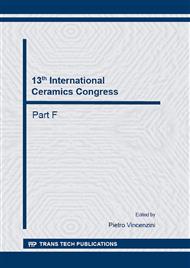p.226
p.232
p.242
p.248
p.258
p.264
p.272
p.282
p.288
Corrosion Mechanism Analysis of Al2O3-SiC-C Castable
Abstract:
The present study aims to analyze the corrosion mechanism of Al2O3-SiC-C castables for blast furnace main trough. The anti-oxidation and corrosion properties of the castable caused by slag were studied with residual lining investigation and microstructure analysis. A rapid recognition of grain distribution, ingredients, and mineral phases was achieved by using cathodoluminescence (CL) in conjunction with stereo microscopy. Different materials such as brown fused alumina, spinel, and low-melting CaO containing phases etc. can be detected due to their distinct fluorescence. The result indicated that when carbon in the matrix of castables was oxidized, its non-wetting property to slag was reduced, which causes slag penetrate into the castable and formed low-melting CaO containing phases. On the contrary, when the anti-oxidation property of castable was improved, the carbon in the matrix was not easily oxidized and corroded by slag. Furthermore, MgO of slag reacted with Al2O3 in the matrix to form a continuous spinel layer, which retarded slag to penetrate and corrode the castable.
Info:
Periodical:
Pages:
258-263
Citation:
Online since:
October 2014
Authors:
Keywords:
Price:
Сopyright:
© 2014 Trans Tech Publications Ltd. All Rights Reserved
Share:
Citation:


